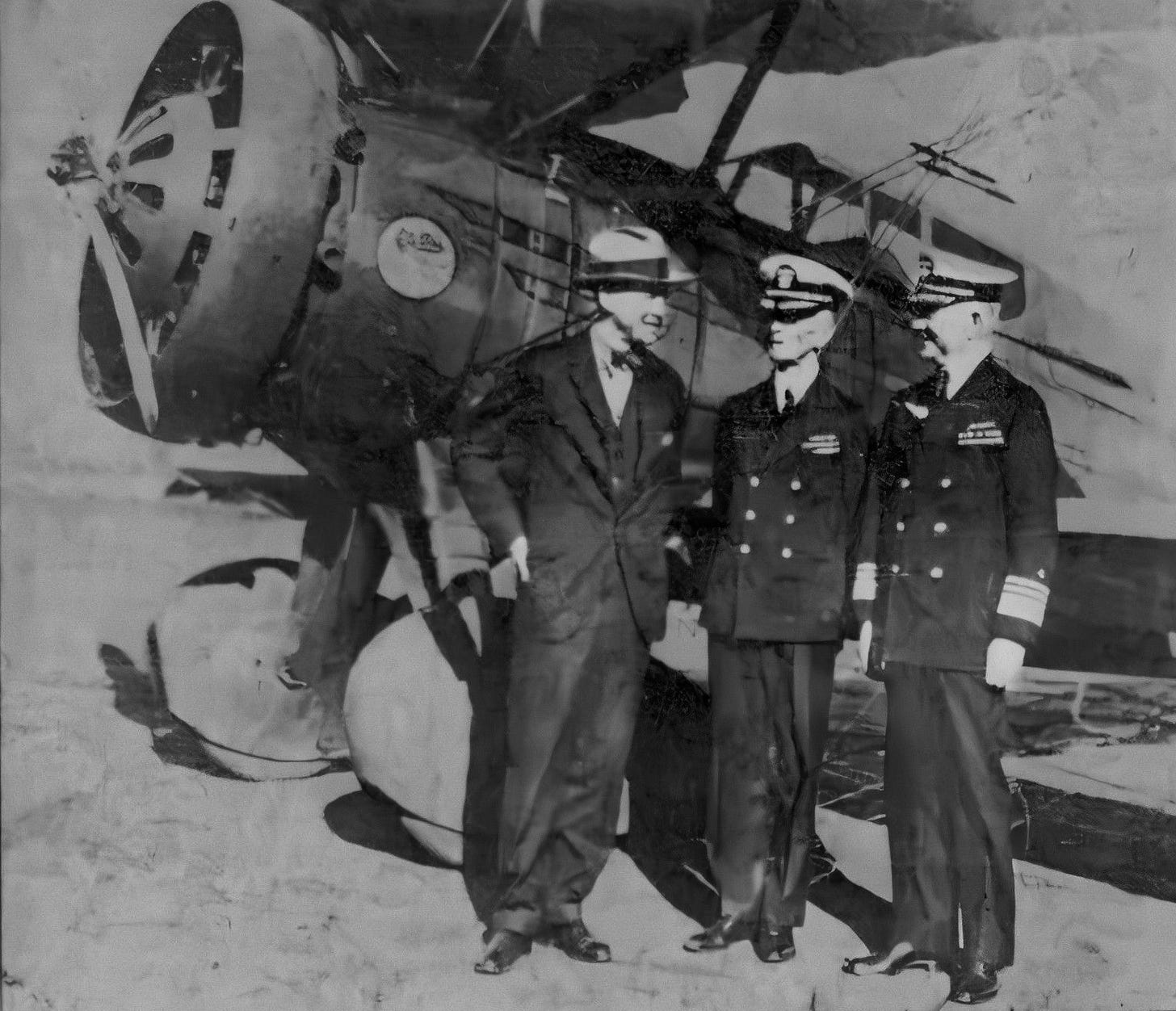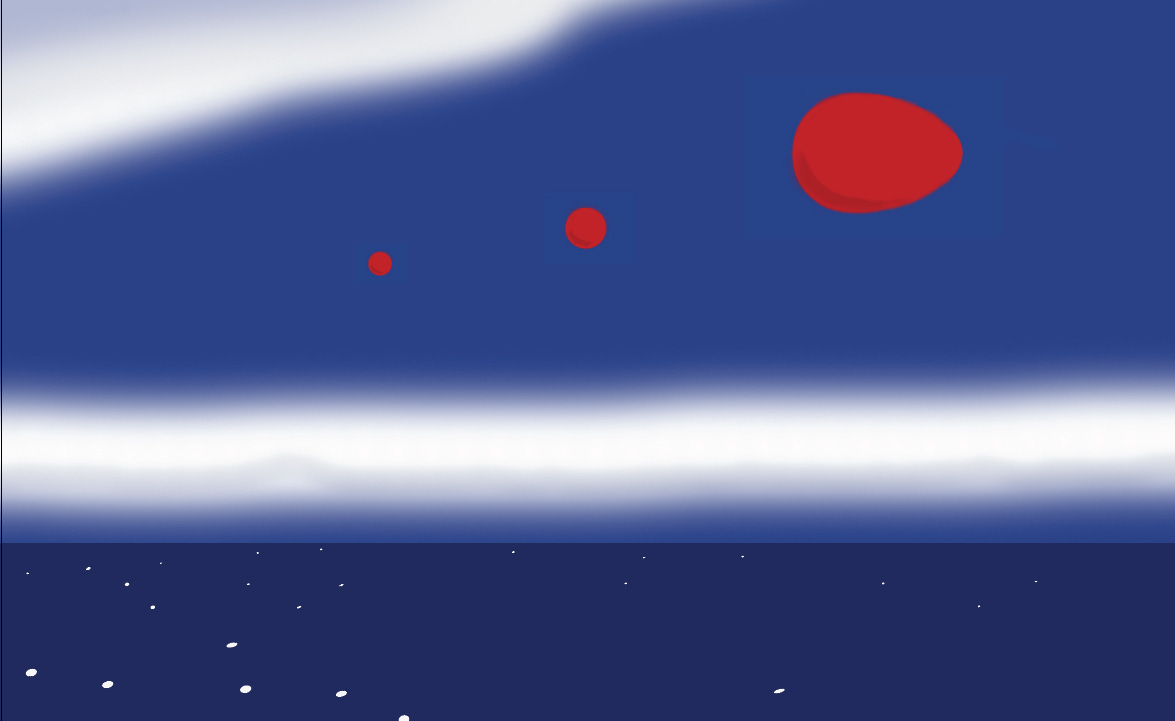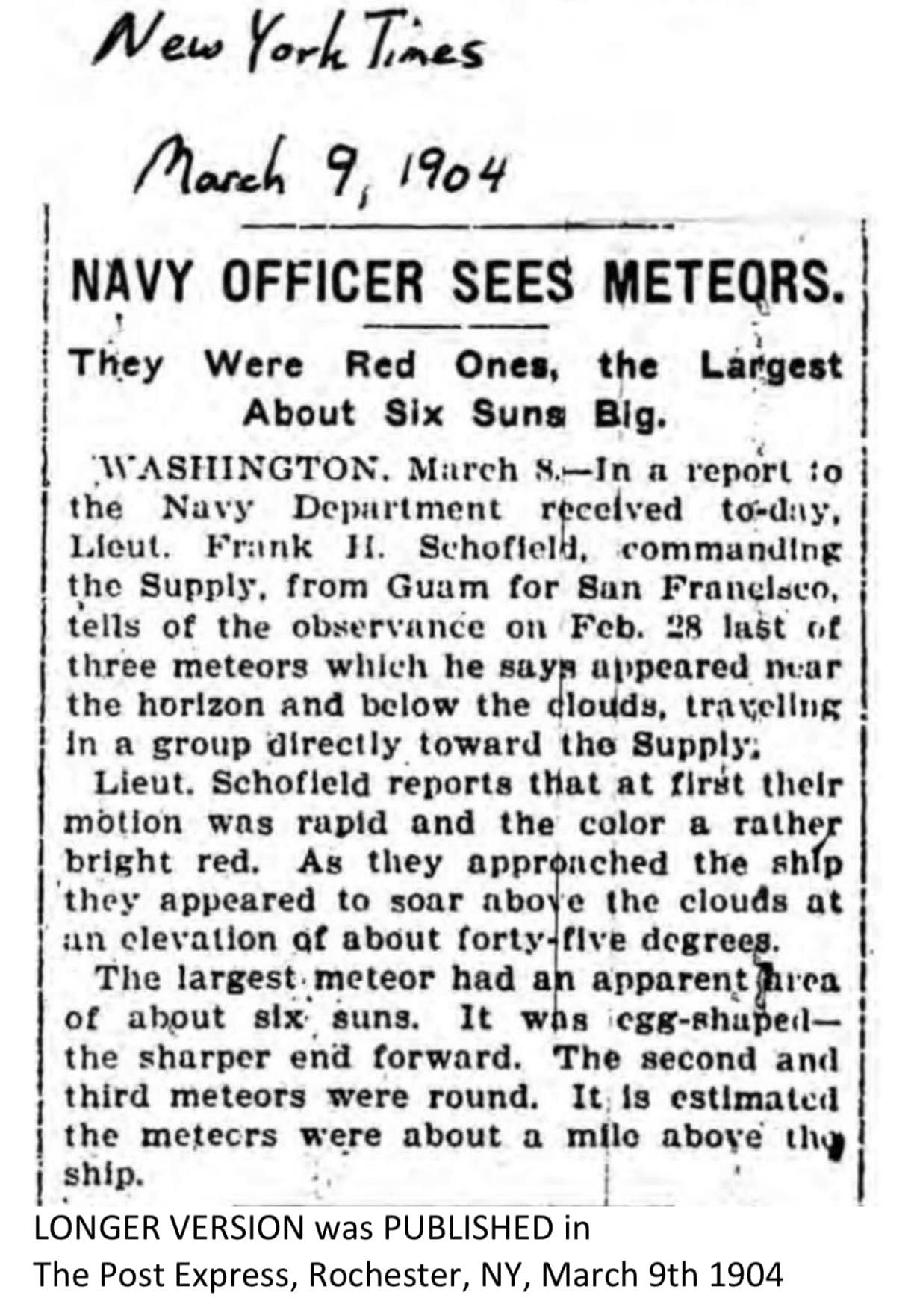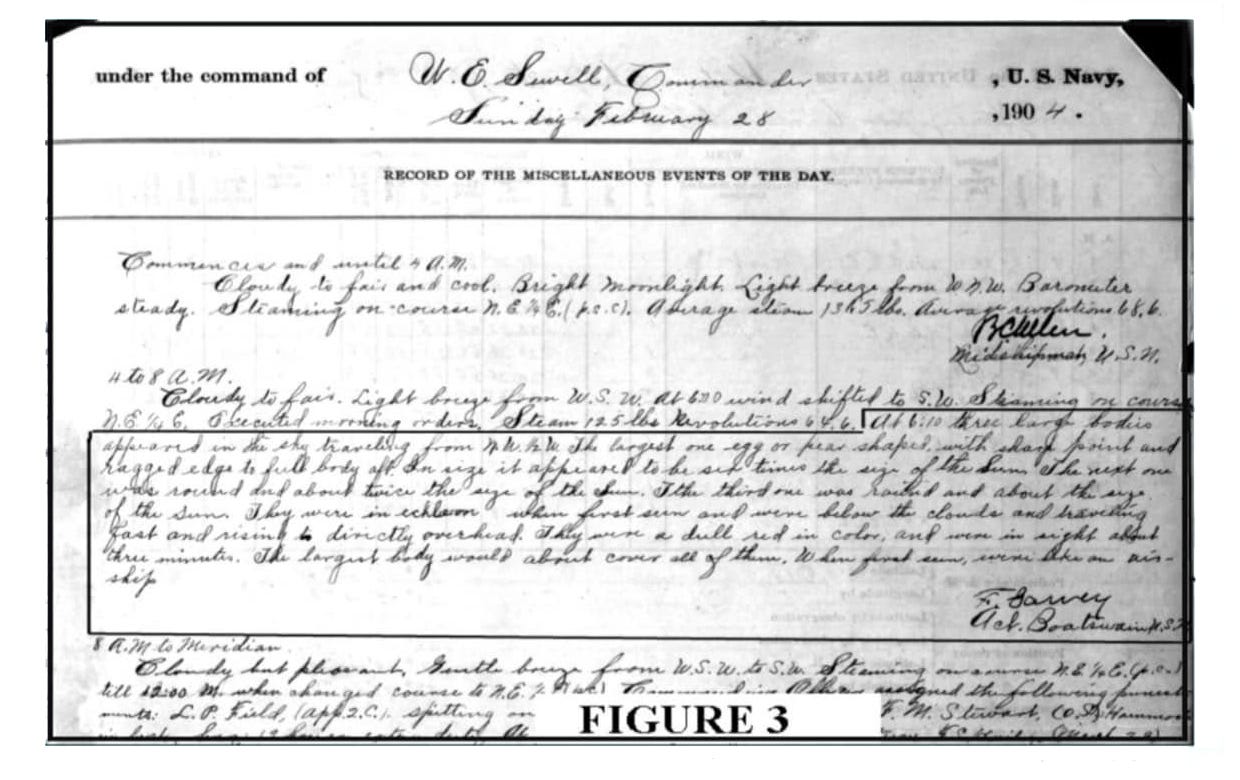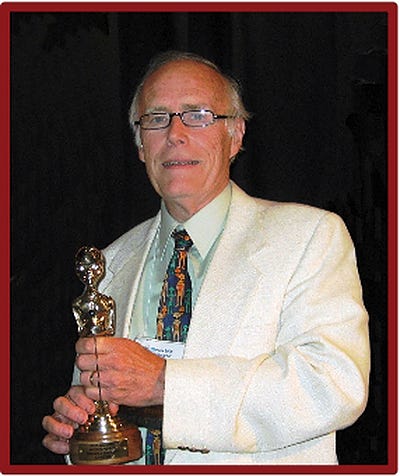USS Supply Reported UAP at Sea in 1904
A young officer saw the promise of naval air power; Dr. Bruce Maccabee gave a master class in the analysis of historic UFO report.
The United States Navy didn’t enter the UFO story when a 45-foot-long Tic Tac buzzed the USS Nimitz in 2004. In reality, the US Navy has long watched, reported and recorded strange and unknown aerial phenomena.
The following report is from the log of the USS Supply, Lt. Frank H. Schofield, USN, commanding. The date was Feb. 28, 1904; the location, the Pacific Ocean about 300 miles southwest of San Francisco, California. The lieutenant, who would in a gallant and storied career rise to Admiral Schofield, USN, Commander-in-Chief of the US Navy, attested to what the Officer of the Deck (on that morning watch, the ship’s assistant boatswain) and two other seamen on watch witnessed at 6:10 a.m., local time:
“0400 - 0800 Cloudy to fair; light breeze from WSW; at 0600 wind shifted to SW; steaming on course NE(1/4)E; executed morning orders; steam 125 lbs., revolutions 64.6. At 0610 three large bodies appeared in the sky traveling from NW(1/2)W. The largest one egg or pear shaped, with sharp point and ragged edge to full body aft. In size it appeared to be six times the size of the sun. The next one was round and about twice the size of the sun. The third one was round and about twice the size of the sun. They were in echeleon (sic) when first seen and were below the clouds and traveling fast and rising to directly overhead. They were dull red in color and were in sight about three minutes. The largest body would cover all of them. When first seen were like an airship.”
A fascinating account from the days before flying saucers, UFOs or UAP were part of the vernacular. Emphasis and the correction of minor typos in this report is by The Residium editor.
Richmond Times-Dispatch, 21 November 1930 — Associated Press Photo. NEW NAVY BATTLE PLANE — Greeted at Long Beach, Cal., by Admiral Frank Schofield (center), and Vice-Admiral Richard H. Leigh (right), David S. Ingalls, Assistant Secretary of the Navy, was high in his praise for his Curtis hell-diver two-seater fighting plane. Mr. Ingalls asserted the plane will outperform and out-maneuver any plane in existence and predicted the two-seater will be the ultimate development in fighting plane design.
An Eye on the Skies
Lt. Schofield was in command of USS Supply, in relief of Lt. Cmdr. William E. Sewell who had fallen ill while serving in the US Territory of Guam. The vessel had been ordered to transport Lt. Cmdr. Sewell to medical facilities in the United States. Unfortunately, this was in the days before penicillin and anti-biotics, and Lt. Cmdr. Sewell died shortly after arriving in San Francisco.
Not on deck when the UFO sighting occurred, Lt. Schofield trusted and valued the word of those under his command. The final entry in the Supply’s log indicated the witnesses stated the objects appeared as an airship. Judging by his amazing insights into the changing nature of warfare over the coming decades, it is possible his experience at sea in 1904 served to illuminate the value of naval air power for him.
Remember the times: The Wright Brothers first flew at Kitty Hawk only 73 days earlier, December 17, 1903. Less than two decades later, the Navy collier USS Jupiter was converted into the world’s first operational aircraft carrier, the USS Langley, commissioned on March 20, 1922.
During the interregnum, Lt. Schofield would rise through the ranks, commanding ships, various commands and eventually the entire fleet. In the process of becoming Admiral Schofield, he became a strong proponent for the power represented by naval aviation.
In the “Grand Joint Exercise Four” war games of early 1932, Admiral Schofield led the attacking force. Approaching Hawaii from the north, he ordered 150 aircraft from the USS Saratoga and USS Lexington carriers to attack defending Navy and Army forces on Oahu.
Referees ruled the engagement a victory for the attacking forces. Denoted in part by sacks of flour dropped from the attacking aircraft onto ships at anchor and airfield runways on land, the Navy planes destroyed the island’s Army Air Force bases and sank all the battleships at anchor in Pearl Harbor.
Admiral Schofield’s force then escaped northward unscathed, journalists and biographers report. The admiral retired a few months afterward. Many of his colleagues considered the success of the attack a “fluke” and did not appreciate the potential of naval air power, preferring battleships on the surface, and when necessary, submarines underwater. However, the concept of surprise attack by naval aviation demonstrated in war games became reality in battle nine years later — “a day of infamy” — December 7, 1941.
Similar in shape to the forward- and back-slash on a computer keyboard (“/” and “\”), an echelon formation is a military tactic applicable to forces on land, sea and air. Echelon formations help units secure their flank and engage threats from multiple directions. Moving forward at an angle provides each member in the echelon with excellent vision, improved maneuverability, and space needed to engage, flank and envelop enemy forces as conditions warrant.
To hear three unidentified objects were seen to employ the tactic in 1904 and in many UAP reports since is a possible observation of intelligent and coordinated military behavior. I believe Lt. Schofield remembered that aspect of the episode at sea, as well.
Readers of The Residium can learn about this important historic record today thanks in large part to work by NICAP (the National Investigations Committee on Aerial Phenomenon) and its leadership, including the late Richard Hall, the late Maj. Donald Keyhoe, USMC (ret.), and membership of civilian researchers to preserve the report. While the original organization is no longer active, NICAP still fields a dedicated corps of ufologists who maintain a database with a body of significant case files and information in a rechartered body.
One brilliant NICAP member, Dr. Bruce S. Maccabee, Ph.D, an optical physicist in the employ of the United States Navy, brought it up for detailed study. Going directly to the original eyewitness statements, and applying his own critical faculties and technical expertise, Dr. Maccabee’s study and report (archived at Netowne.com) stand as a “Master Class” in historic UFO analysis.
“I decided to do something no one else had ever done before... I decided to check the original record to see if there was anything left out of Schofield's report. There was.”
— Dr. Bruce Maccabee, Ph.D
The USS Supply Sighting of 1904
by Bruce Maccabee
via NICAPIn his premier issue of the “UFO Historical Review,” author Barry Greenwood has presented what would seem to be a reasonable explanation for a sighting of three glowing bodies passing through the atmosphere by several members of the crew of the USS Supply, a Naval ship, on February 28, 1904. Greenwood has made the not-surprising suggestion that these were meteors. The main factors that seem inconsistent with the meteor hypothesis are the claims that (a) the meteors “did come below the clouds” estimated at about 1 mile (1.6 km) high, (b) they did “soar instead of continuing their southeasterly course” which would have taken them over the ship and (c) they were seen for “over two minutes.” The quotes are from the report written by Lt. Frank H. Schofield as published in the Monthly Weather Review, March, 1904 and reproduced below. (Note: Schofield eventually became the Chief of Naval Operations.) The meaning of “soar” as used here is that the glowing objects appeared to travel roughly horizontally (constant altitude) below the clouds as they approached the ship, and then they appeared to climb through the cloud altitude and move directly away from the ship, to “soar” into the heavens, at a constant angular elevation of about 75 degrees (but not radially away from the center of the earth; the angular elevation would have to be 90 degrees for a radial departure). Schofield’s report, entitled “Remarkable Meteors,” begins as the objects were first sighted by the Officer of the Deck and then by two other people on deck. The objects “appeared near the horizon and below the clouds, traveling in a group from northwest by north (true) directly toward the ship. At first their angular motion was rapid and color a rather bright red. As they approached the ship they appeared to soar, passing above the clouds at an elevation of about 45 deg. After rising above the clouds their angular motion became less and less until it ceased, when they appeared to be moving directly away from the earth at an elevation of about 75 deg. and in direction west-northwest (true). It was noted that the color became less pronounced as the meteors gained in angular elevation. When sighted the largest meteor was in the lead, followed by the second in size at a distance of less than twice the diameter of the larger and then by the third in size at a similar distance from the second in size. They appeared to be traveling in echelon and so continued as long as in sight. The largest meteor had an apparent area of about six suns. It was egg shaped, the sharper end forward. This end was jagged in outline. The after end was regular and full in outline. The second and third meteors were round and showed no imperfections in shape. The second meteor was estimated to be twice the size of the sun in appearance and the third meteor about the size of the sun. When the meteors rose there was no change in relative position; nor was there at any time any evidence of rotation or tumbling of the larger meteor. I estimated the clouds to be not over 1 mile high. The near approach of these meteors to the surface and the subsequent flight away from the surface appear to be most remarkable, especially so as their actual size could not have been great. That they did come below the clouds and soar instead of continuing their southeasterly course is also equally certain, as the angular motion ceased and the color faded as they rose. The clouds, in passing between the meteors and the shop completely obscured the former. Blue sky could be seen in the intervals between the clouds. The meteors were in sight for over two minutes and were carefully observed by three people, whose accounts agree as to details. (the Officer on Deck) sent a messenger to me who brought an untelligible message. When I arrived on the bridge the meteors had been obscured for about one-half minute.”
Click here to read the official History of USS Supply.
Lt. Schofield carefully interviewed the witnesses shortly after the sighting and then compiled this report which would have us believe that “meteors” traveled “in echelon” (a flying formation) underneath the 1 mile high cloud layer and then rose upward, passing above the cloud layer and apparently moving directly away from the ship. As Greenwood pointed out in his article, the statement that they were traveling for a period of time below the clouds is sufficient to reject the meteor hypothesis. The report of traveling “in echelon” and then rising upward above the clouds further contradicts the meteor explanation. Nevertheless, Greenwood argues that these were meteors for the following reasons:
1). although the witnesses claimed that the objects were below the clouds, this was an “optical illusion” because they were initially at a very great distance near the horizon; they only appeared to the “below the clouds”; they were only seen through “intervals” in the cloud cover; hence they could have been far above the clouds.
2). the initial great distance made them look red (atmospheric reddening, as with sunlight on the horizon) and as they traveled along they got closer to the ship so the distance light had to travel through the atmosphere continually decreased and the red color diminished.
3). the existence of three objects can be explained as a result of a single large meteor breaking into three parts.
4). there were no trails reported, but meteors don't always have trails.
5). the two minute duration is not inconsistent with known durations of meteors (Greenwood cites a 100 sec meteor observation in 1972).
These reasons seem “reasonable.” And yet, Schofield seemed “awfully certain” that these objects were below the clouds. As Greenwood stated in his article, “...if the objects were below a cloud cover...it is unlikely that they were meteors without their having impacted nearby. It also strains logic to think that large meteors would take an upward turn that close to the surface and disappear from view.”
More than 20 years ago, when I became interested in this sighting report (published in NICAP's UFO Evidence) I decided to do something no one else had ever done (and Greenwood did not do). I decided to check the original record to see if there was anything left out of Schofield's report. There was.
The log of the U. S. Naval Ship Supply is at the National Archives. For the date and time in question we read: "0400 - 0800 Cloudy to fair; light breeze from WSW; at 0600 wind shifted to SW; steaming on course NE(1/4)E; executed morning orders; steam 125 lbs., revolutions 64.6. At 0610 three large bodies appeared in the sky traveling from NW(1/2)W. The largest one egg or pear shaped, with sharp point and ragged edge to full body aft. In size it appeared to be six times the size of the sun. The next one was round and about twice the size of the sun. The third one was round and about twice the size of the sun. They were in echeleon (sic) when first seen and were below the clouds and traveling fast and rising to directly overhead. They were dull red in color and were in sight about three minutes. The largest body would cover all of them. When first seen were like an airship.”
Supplemental information registered in the log at 0600 hours includes: "wind 9.8 knots, SE, force 2, barometer 30.38, air temperature 62, water temperature 58" and the all-important information on clouds that is only hinted at by Schofield: "stratus, moving from north, coverage 9." Stratus are horizontally layered cloud caused by atmospheric cooling over large horizontal areas. They are not very thick vertically and can exist from the surface (where they are essentially fog) up to a mile or more. "Coverage 9" indicates that the sky was about 90% covered by the cloud layer which was moving southward (coming from the north).
Mr. Greenwood's hypothesis is that the supposed meteor (which subsequently broke up) entered the atmosphere hundreds of miles from the ship in the direction of the initial view (NW by 1/2 W or about 292 degrees azimuth). Its track took it directly toward the ship as it curved around the surface of the earth. Subsequently it began to glow and then split into three parts. Eventually it became visible to the Supply officers on deck while at a distance of perhaps 800 km or about 500 miles. For Greenwood's hypothesis to work it would be necessary that there be NO cloud cover in the direction of the meteors when they were first seen and, furthermore, that there was no cloud cover in the direction of the meteors until the they got much closer to the ship at an angular elevation of about 45 degrees when they reportedly rose through the cloud layer. It would be at this time that clouds started to block the direct view. This means that there had to be a "slot" or opening in the 90% cloud cover from the horizon up to an angular elevation of at least 45 degrees, with the axis of this slot aligned with the azimuth of the “meteors.” This is, of course, possible, but highly unlikely considering the layered nature of stratus clouds.
Mr. Greenwood's hypothesis as described and illustrated by his drawings can be illustrated by imagining a straight line path of a meteor above the curved surface of the earth. Assume this meteor started to glow at an altitude of about 100 km (60 miles), then penetrated the atmosphere to a depth of about 50 km (30 miles) and then continued along a substantially straight path that took it away from the earth, probably becoming invisible as it reached once again about 100 km altitude. It would have reached 100 km just before it was over the ship so that its highest observed angular elevation would have been about 75 degrees. (Note: the actual track of a meteor this close to the earth is a slight curve with radius much greater than the radius of the earth, 6328 km or about 4,000 miles. However, use of a curved-path in this illustration would seriously complicate the analysis and provide little further information. Of course, the “ultimate” curved path for a non-crashing object is parallel to the surface of the earth, i.e., an orbit with radius of curvature (6328 + H), where H is the minimum height of the object. No grazing meteor track would have a radius this small.) Further, his hypothesis would require that the first view of this meteor (or group) was at the time that it was about at its lowest altitude. Assume, then, that it was 50 km high when first seen. By geometry one can show that if it was first seen at 50 km altitude while traveling along a straight path that would pass through 100 km altitude over the ship, then its distance would have been about 800 km or 500 miles away and it would have been right on the horizon. Initially the angular elevation would have increased slowly, but then the rate of increase of elevation would itself increase, being the most rapid as the meteors disappeared nearly over the ship (with looking almost straight up as the meteors traveled nearly a horizontal path over the ship), in contradiction to Mr. Greenwood's suggestion that the rate of increase of angular elevation would decrease as the meteors moved away from the earth.
If the meteors were climbing out of the atmosphere, and hence cooling and hence glowing less as they approached the ship, they might fade to invisibility before passing over the ship but at no time would the angular elevation seem to stop increasing as long as the meteors were visible. In other words, there is no way that glowing meteors could appear to stop their approach to overhead, i.e., to stop the increase in angular elevation, and then fade out as if moving directly away from the ship at an elevation of 75 degrees. The observation that the angular elevation ceased to increase once it reached about 75 degrees seems to be completely incompatible with the meteor hypothesis.
Mr. Greenwood has suggested that a sighting duration of “over two minutes” is unusual, but not an impossible meteor duration. Of course, we see now that the actual observer who wrote the entry into the ship’s log placed the duration at about 3 minutes, so Schofield was being conservative. A good question to ask at this point would be, what is the longest duration that one might expect to see a meteor? I answered this question some 20 years ago at a time when the Coyne-helicopter case was being debated. Since Greenwood referred to the 1972 fireball meteor, let’s use it as an example. It became visible when it was about 90 km high and at its lowest it was about 60 km high. This was a “skipping meteor” which passed through the upper atmosphere of the earth, glowed, and then “bounced off” the atmosphere and continued its travels through the void of space (having suffered a severe deviation from its initial track). Now imagine as before a straight line cutting through a circle, where the circle represents that atmosphere at 90 km altitude (above the circular earth) and the straight line is a good approximation to the path of a meteor. The closest distance of the straight line to the surface is 60 km. One can show using geometry that the **straight line path** from 90 km above the surface down to 60 km and back up to 90 km (5 degrees elevation) is a distance of about 1250 km. The 1972 fireball traveled at roughly 14.5 km/sec on average. If we use this as an estimated speed for the Supply “fireballs” than, if someone had watched it from the beginning to the end of its glow, he would have seen it for about 1250/14.5 = 86 seconds (an observer exactly under the center of the glowing path would see this traveling from horizon to horizon in 86 seconds). (Note: the 1972 meteor approached the earth from behind at about 10 km/sec, but then accelerated as it got closer and was traveling at about 14.5 km/sec relative to the surface of the earth at its closest approach.) Of course, the meteor did not travel in a straight line, but rather curved over the earth and hence traveled a slightly longer path in the atmosphere than calculated here. A space satellite that observed the meteor in infra-red light estimated the glow path was about 1500 km and the duration of visibility to the satellite was a bit over 100 seconds. (This satellite was able to detect the infra-red glow before the meteor made the atmosphere hot enough to be visible to the eye, and then the satellite was able to “see” the meteor longer then the naked eye.) This is the value quoted by Greenwood as if a ground observer could have seen it for that duration, but, of course, no ground observer could see it that long. Actually the ground observed durations ranged up to 1 minute with most of the observations being 40 seconds or less. The famous film of this fireball lasts “only” 26 seconds.
One concludes from this analysis that it is virtually impossible to see a meteor **from horizon to horizon** that lasts as long as 100 seconds. The USS Supply officers sighted the meteors, not from horizon to horizon, but at most about halfway, from the horizon to overhead. This would take half as long, say 50 seconds or less. Hence the claimed duration of “over 2 minutes” and perhaps as much as 3 minutes lies far outside the normal meteor duration of visibility. These were truly remarkable, i.e., remarkably slow, meteors. (Note that **orbiting** bodies in low earth orbit could have observation durations this long, but they would not escape the orbit, so they would not appear to soar. Furthermore, to maintain a glow, such an orbiting body would have to travel at a high altitude, far above the clouds to avoid frictional energy loss that would slow it further and cool it below glowing speed.)
The “bottom line” on the meteor hypothesis is that it is strained, at the very least, by the observation that they appeared to travel beneath the clouds (considering the 90% cloud cover), strained even further by the observation that the angular motion ceased and they appeared to travel directly away from the ship, and finally it is rejected by the reported duration of over 2 minutes.
A brilliant physicist and a dedicated public servant, Dr. Bruce S. Maccabee used his scientific training to advance our understanding of UFO phenomenon. He is shown in the photo above holding the “Lifetime Achievement Award” from the International UFO Congress.
Dr. Maccabee worked at the Naval Ordnance Laboratory / Naval Surface Warfare Center from 1972 to 2008 in Silver Spring, Maryland. He earned a Bachelor’s of Science degree from Worcester Polytechnic Institute of Worcester, Massachusetts, and his Master’s and Ph.D from American University in Washington, DC. Dr. Maccabee passed away in 2024. He was 82 years of age.
Ufologist Elizabeth Moulton Howe published a remembrance on her outstanding website, Earth Files:
Dr. Maccabee joined the National Investigations Committee On Aerial Phenomena (NICAP) in the late 1960s. Later in 1975 Dr. Maccabee also became a member of the Mutual UFO Network and then became Maryland’s MUFON State Director. Among his many UFO investigations was his re-analysis of the statistics and results of the famed Battelle Memorial Institute Project Blue Book Special Report No. 14, that was a very large analysis of 3,200 U. S. Air Force cases from the 1940s to 1950s.
One More Word
Barry Greenwood is an important figure and leader in the field of ufology, as well. With Lawrence Fawcett, he co-wrote “Clear Intent: The Government Cover-Up of the UFO Experience.” A pioneering exploration of UFOs and democracy, the work shares what was known at the time about the phenomenon in context with its impact on our national security — in balance with our Constitutional rights as citizens of the United States of America. Here’s a brief biography posted by the Center for UFO Studies.



